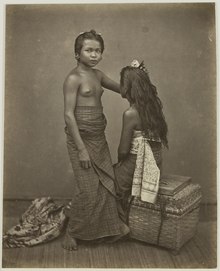| Part of a series on |
| Forced labour and slavery |
|---|
 |





Chattel slavery excisted in the territory that would become the modern state of Indonesia until the 20th-century. Due to the fact that the Maritime South Asian archipelago corresponding to Indonesia was not unified until 1949, the history of slavery in Indonesia is not uniform, but did have common features and a somewhat common history.
Slavery and slave trade is known to have excisted during the Ancient Hindu-Buddhistic states in Indonesia, though the information is somewhat limited. When the islands converted to Islam and transformed into Islamic sultanates during the 15th-century, the institution of slavery came to be managed in accordance with Islamic law and therefore took on similar characteristics as the slavery in the rest of the Muslim world, and non-Muslim peoples were captured by Muslim pirates from the Sulu and Celebes who sold them to slavery in the Islamic sultanates.
From the 17th-century onward, the Company rule in the Dutch East Indies (1610–1800) and then the Colonial Dutch East Indies (1800–1949) expanded over the archipelago. The Dutch colonists used slave labor in their agriculture. The Dutch banned slave trade in 1811 and slavery in 1860. The Dutch prohibition of slavery expanded in parallell with the Dutch control ove the archipelago, and by 1910, slavery in the East Indies was seen as effectively abolished, though cases of chattel slavery was still discovered as late as the 1940s.
